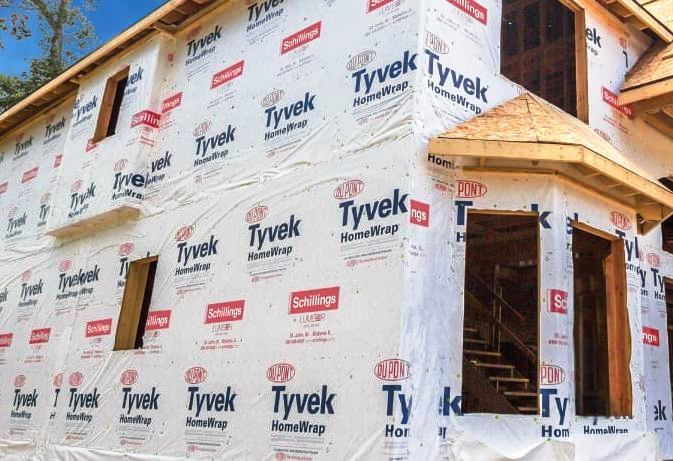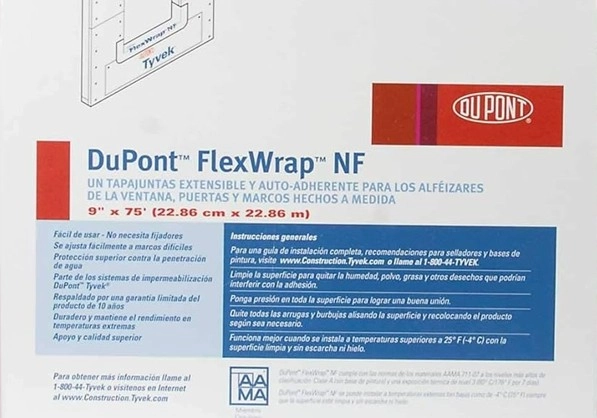Can Tyvek Be Used on Interior Walls?

Tyvek offers a wide range of applications. Tyvek is utilized as a house wrap in the construction business. Tyvek is one of the best house wraps available because of its features, which include being breathable, long-lasting, tear-resistant, and water-resistant.
On a building’s exterior, Tyvek is frequently utilized for construction purposes. However, does it still have the same advantages when applied to interior walls? This is going to be our main conversation topic.
Is Tyvek adequate for interior walls?
The makers of Tyvek, Dupont, advise against using this house wrap on inside walls. Tyvek is intended only to be used behind external walls.
It is usually advised to follow the manufacturer’s directions while using building materials. Follow the manufacturer’s directions if you plan to use Tyvek on the interior walls.
How Dangerous Is It to Apply Tyvek to Interior Walls?
Mold growth is the main concern when applying Tyvek to interior walls. I understand that you are questioning how it’s possible given that Tyvek forms a barrier that is permeable and permits vapor to travel through. This is a detailed explanation of what happens to interior walls treated with Tyvek.
To begin with, you must comprehend Tyvek’s operation. Tyvek stops liquid water from permeating the surface when it is used as a house wrap. Nevertheless, it also permits moisture to escape the walls, enabling the structure to breathe.
Installing Tyvek on interior walls presents a problem since it lets moisture from the outside seep through and collect on internal sheathings like OSB, plywood, or drywall. Moisture accumulation will cause mold to progressively grow.
Outside walls are the best spot for you to install Tyvek. Tyvek will stop water leaks or seepage via an external wall.
Simultaneously, it will facilitate the inside walls’ respiration and eliminate surplus moisture, preventing the growth of mold. Applying Tyvek to inside walls invites mold growth into your house.
What Happens If It’s Mounted On An Interior Wall Backward?
If you enjoy do-it-yourself projects, you might think of mounting the Tyvek backward on a wall inside. The result will essentially be the same. Indoor spaces do contain moisture, particularly bathrooms and kitchens.
Installing Tyvek backwards allows moisture from the interior to seep through, where it can become trapped behind the walls and lead to the growth of mold. Regardless of whether you install it facing the front or the back, it’s a lose-lose situation.
Is it Better to Use Tyvek Warm or Cold?
The exterior of the house is on the cold side. You will get the full advantages of Tyvek when you utilize it here. It will eliminate any moisture present within the walls and stop any leaks of water.
The interior, which is on the warmer side, is where you want to choose a material that keeps vapor out. This keeps moisture from becoming trapped inside the walls, preventing rot and the growth of mold.
Is there only one way for Tyvek to transmit water vapor?
Tyvek shouldn’t be used on interior walls for a number of reasons, chief among them being its capacity to allow water vapor to travel through.
Given the explanation provided above on interior wall applications, one may wonder if Tyvek just transmits water vapor in one direction.
Unquestionably, one of the most inventive building materials ever created is Tyvek. It is true that a permeable, water-repellent membrane is an artistic creation.
According to Tyvek’s design, the front surface functions by preventing liquid water from passing through. As a result, it repels water. The substance at the rear allows vapor to travel through.
According to the manufacturer’s description, Tyvek only permits one-way vapor transmission. However, from a scientific perspective, if Tyvek is able to allow moisture to enter from the rear,.
This implies that moisture will also pass through at the front end. You need to give this careful thought before applying Tyvek to your interior walls.
When Tyvek is used on interior walls, its water-repellent properties are not something you will like.
Tyvek’s water-repellent characteristic is another drawback when applying it to interior walls. A wall on the inside shouldn’t have any water leaks.
And if so, they must be addressed right away to prevent the growth of mold. In the construction business, tyvek is mostly used to keep water from destroying building components. When applied to an inside wall, the water-repellent properties are not beneficial.
Is Tyvek a better insulation option?
Tyvek has the ability to block air. As an alternative, you might think about utilizing Tyvek in an uninsulated house. Sadly, Tyvek lacks the ability to act as an insulator and is not an insulating material.
Is Tyvek a Barrier to Vapor?
The complete opposite of a vapor barrier is tyvek. Tyvek does not stop moisture from going through; rather, it facilitates it. Therefore, it is inappropriate to put this material on an interior wall.
Don’t be tempted to utilize the extra Tyvek you have after placing it on the outside walls as an alternative. If this is done, the materials on the internal walls will completely fail. Mold poses a major health concern as well.
Which Material Is Ideal for Interior Walls?
The best material to use as a vapor barrier for interior walls is polyethylene sheeting. The way this vapor retarder seals walls is amazing.
Applying poly beneath drywall produces a tight barrier that keeps moisture out. This guarantees that there isn’t any vapor between the walls, which could encourage the growth of mold.
Is Tyvek suitable for interior walls?
It’s not a good idea for you to put Tyvek on interior walls, to put it mildly. If this concept has occurred to you, you should disregard it right away.
Research has several benefits, one of which is that it keeps you out of trouble. These are some of the reasons why it’s not a good idea to install Tyvek on interior walls.
The perm rating of a common vapor barrier is less than 1. However, because Tyvek is made to allow moisture to pass through, it has an exceptionally high perm rating.
Moisture will travel through a product with a high perm rating, like Tyvek, and if the weather is particularly cold, it will condense into water.
In the end, Tyvek is not appropriate for interior walls. It is preferable that you use an appropriate vapor barrier.
Should You Use Tyvek in Climates That Are Warm and Humid?
Tyvek is used in the interior walls of dwellings in warm, humid locations with the presumption that the outside temperature is not chilly and will not cause vapor to condense as it passes through the Tyvek.
The weather conditions to which your residence is exposed are irrelevant. Inside walls are not the right place to use Tyvek. Owners of real estate should follow the appropriate building standards and codes.
The moisture that seeps through the Tyvek will eventually cause the interior walls to become damp, even in warm climes. It is preferable to use the right supplies and steer clear of issues that might arise later.
How about FlexWrap?
Self-adhering butyl flashing, FlexWrap, is frequently used in conjunction with Tyvek. FlexWrap may be applied to interior walls, unlike Tyvek. Particularly on interior walls at door and window sills, it works incredibly well.
One of the benefits of utilizing FlexWrap is that it forms a barrier against water and air. FlexWrap ought to be used sparingly. For instance, let’s say you want to seal the internal wall seams.
Is Tyvek an Important Interior Wall Component?
No. Tyvek is a substance that needs to be reserved for outside walls that need extra defense against water damage.
A wall is made up of numerous parts, both inside and outside. Thankfully, Tyvek isn’t among them. You shouldn’t use it on any area of your walls for any reason.
What Use Does Tyvek Serve?
After ruling out the idea that internal walls should not be covered in Tyvek, we must specify the primary functions of this product.
Made of polyethylene fibers, Tyvek is a synthetic material. It is impervious to bacterial growth, aging, and air and water penetration.
It’s one of the greatest house wraps because it’s also very breathable. Tyvek can be used to create PPEs, sterile goods, cargo covers, industrial packaging, and contemporary envelopes in addition to house wraps.
Tyvek can be put to a lot of use. But for building projects around the house, Tyvek makes a great house wrap that will keep the materials dry and allow them to “breathe.”
Only when Tyvek is used on external walls are all these advantages applicable.

